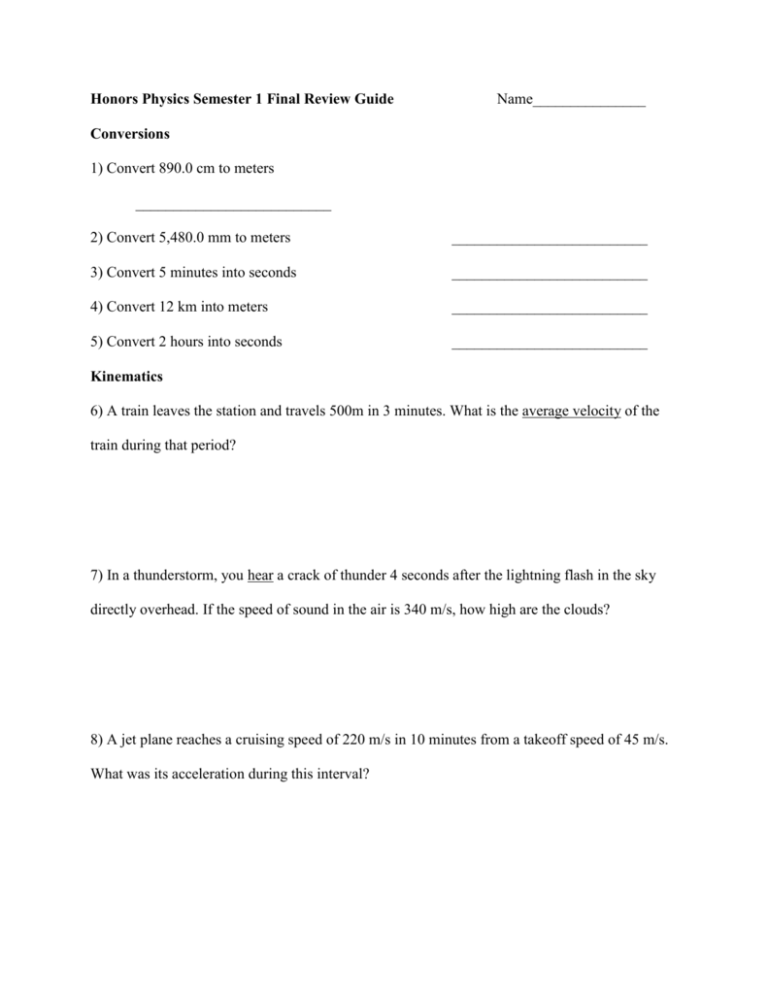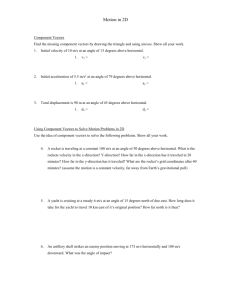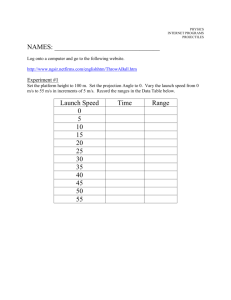Honors physics review s1
advertisement

Honors Physics Semester 1 Final Review Guide Name_______________ Conversions 1) Convert 890.0 cm to meters __________________________ 2) Convert 5,480.0 mm to meters __________________________ 3) Convert 5 minutes into seconds __________________________ 4) Convert 12 km into meters __________________________ 5) Convert 2 hours into seconds __________________________ Kinematics 6) A train leaves the station and travels 500m in 3 minutes. What is the average velocity of the train during that period? 7) In a thunderstorm, you hear a crack of thunder 4 seconds after the lightning flash in the sky directly overhead. If the speed of sound in the air is 340 m/s, how high are the clouds? 8) A jet plane reaches a cruising speed of 220 m/s in 10 minutes from a takeoff speed of 45 m/s. What was its acceleration during this interval? 9) A stone is thrown vertically upward with an initial speed of 8 m/s. How high will the stone rise? How long will it take the stone to return to the ground after it is thrown? Projectiles 10) The projectile below has an initial velocity of 15 m/s and is launched at a 50 degree angle. Label the initial velocity, final velocity, range, hmax , and the Vy at hmax 11) The projectile above has an initial velocity of 15 m/s and is launched at a 50 degree angle. Calculate the Vx, Vy, Vf, hmax, acceleration and range. 12) A penny is dropped from a building 40 m tall. How long does it take to hit the ground? (neglecting air resistance) 13) Mr. Gattone ninja kicks a ball horizontally off a 20 m cliff with an initial velocity of 10 m/s. Find the Vx, Vy, at the bottom of the cliff along with the time of flight. 14) A projectile's velocity is constant in the _______ direction while the velocity in the ________ direction changes. 15) A ball is launched at a 25 degree angle, what other angle will achieve the same range? Graphing 16) The slope (rate of change) of a position vs time graph graph represents _________________. 17) The slope (rate of change) of a velocity vs time graph represents ______________________. 18) The area under a velocity vs time graph represents ______________________. 19) The area under an acceleration vs time graph represents ______________________. Use the graph above for questions 18-21 20) Find the average acceleration from 12-15 seconds. 21) What is the velocity at 9 seconds? 22) Find the displacement from 0-5 seconds. 23) Create a position vs time graph for 0-15 seconds. 24) Draw the graphs for the following relationships: a) Direct b) Inverse 25) Construct a graph for the following conditions: a) No slope b) positive constant slope slope c) parabolic c) positive increasing Vectors 26) Besides units Vectors must have _____________ and ______________ while Scalars must have only ____________. 27) A pirate ship is traveling due north at 55 m/s encounters a wind blowing due east at 20 m/s. What is the ship’s resultant velocity and direction? 28) The Millennium Falcon is traveling 350 m/s at 60 degrees North of East. Find the North and East components of this amazing space ship. Optics 29) Draw the following: Include the object a) Converging Mirror b) Diverging mirror c) Concave mirror d) Convex mirror c) Concave Lens d) Convex Lens 30) Draw the following: Include the object a) Converging Lens b) Diverging Lens 31) As light goes from a more dense medium to a less dense medium it bends______________the normal. 32) As light goes from a less dense medium to a more dense medium it bends_______________the normal. 33) What is the critical angle? When does it occur? What is the equation to find the critical angle? 34) Where must the object be located to meet the following conditions Mirrors Larger Smaller Same Real Virtual 35) Where must the objects be located to meet the following conditions Lenses Larger Smaller Same Real Virtual 36) State the Law of Reflection. 37) Draw an angle of incidence of 70 degrees as measured from the normal, draw and calculate the angle of reflection. 38) Name 3 characteristics of images produced in a plane mirror. 39) The normal makes what angle with the surface? 40) Write Snell’s Law 41) What is the speed of light in a vacuum? In water? 42) Measure the angle of incidence, then calculate and draw in the angle of refraction. 43)Find the angle that the light ray leaves the situation below. 44) A 5 cm tall Mr. Pelz bobblehead doll is placed 20 cm from a concave mirror which a radius of curvature of 30 cm. Find where the image is located, the size of the image and if it is real or virtual. 45) For the following 30, 60, 90 triangle, find the angle at which the light ray leaves the Lucite and enters air. Waves 46) Describe the motion of a wave at the nodes. 47) Describe the motion of a wave at the antinodes. 48) In 10 seconds 40 waves pass by a stationary point. Two of the waves are measured to be 20.0 cm long. a) Find the time needed for 1 wave to occur. b) Find the frequency. c) Find the wavelength. d) Find the velocity. e) If the frequency is changed to 2 Hz, what is the new wavelength. 49) When a wave goes from a more dense medium to a less dense medium, what happens to the following: a) Amplitude b) Wavelength c) Velocity d) Frequency 50) A wave is traveling at 30 m/s in a ripple tank. What is the velocity if: a) Frequency is doubled b) Wavelength is cut in half c) Amplitude is tripled 51) An example of a transverse wave is_________________ and a longitudinal wave is___________. 52) What is the Doppler Effect? 53) If an open tube is 1.2 m long, find the frequency and wavelength for the first 4 harmonics assuming the velocity is 340 m/s. 54 )Describe the particle motion compared to the wave motion for the following waves: a) transverse b) sound c) electromagnetic d) longitudinal e) Light 55) What type of interference is shown below? Draw the resultant wave when they meet. Then draw the wave after they have passed through each other. 56) What is diffraction? Give an example of diffraction. Answer Key 1) 8.900 m 2) 5.4800 m 3) 300 seconds 4) 12,000 m 5) 7200 seconds 6) v = 2.78 m/s 7) d =1360 m 8) a = .29 m/s2 9) d= 3.28 m t = 1.63 seconds 10) 11) Vx = 9.64 m/s Vy = 11.5 m/s Vf = 15 m/s range = 22.6m a=9.8m/s2 hmax = 6.75m 12) t = 2.86 seconds 13) Vx = 10 m/s Vy = 19.8 m/s t = 2.02 seconds 14) x ; y 15) 65 degrees 16) velocity 17) acceleration 18) displacement 19) change in velocity 20) -2 m/s2 21) 4 m/s 22) 10 m 23) 24) 25) 26) magnitude, units ; magnitude 27) 58.5 m/s @ 20 degrees East of North 28) y = 303 m/s x = 175 m/s 29) 30) 31) away 32) towards 33) angle at which light will reflect instead of refract; when going more to less dense, critical angle = sin-1(n2/n1) 34) 35) 36) angle of incidence = angle of reflection 37) angle of reflection = 70 degrees 38) virtual, di=do, upright, same size 39) 90 degrees 40) n1sin∅ 1 = n2sin∅ 2 41) 3.0 x 108 m/s 2.26 x 108 m/s 42) 43) 44) di = 60 cm hi = -15cm Virtual 45) 46) no motion 47) max motion 48) a) .25 seconds b) 4 hz c) 10 cm d) 40 cm/s e) 20 cm 49) a) decrease b) increase c) increase d) same 50) a) 30 m/s b) 30 m/s c) 30 m/s 51) Light, Sound 52) the apparent change in frequency due to the relative motion of the observer and the source 53) f1 = 141.7 Hz f2 = 283.3 Hz f3 = 425Hz f4 = 566.7 Hz ℷ 1 = 2.4 m ℷ 2 = 1.2 m ℷ 3 = .8 m ℷ 4 = .6 m 54) a) perpendicular b) parallel c) perpendicular d) parallel e) perpendicular 55) 56) The bending of waves as they pass through or around a barrier. Wave breaks 57) 10 N 58) 80 N Mr. Connell’s hand 59) The law of inertia (an object’s resistance to change); An unbalanced force causes a mass to accelerate; forces come in pairs (action reaction)







